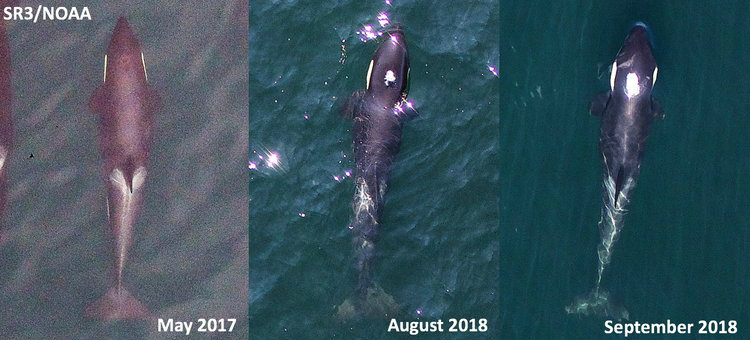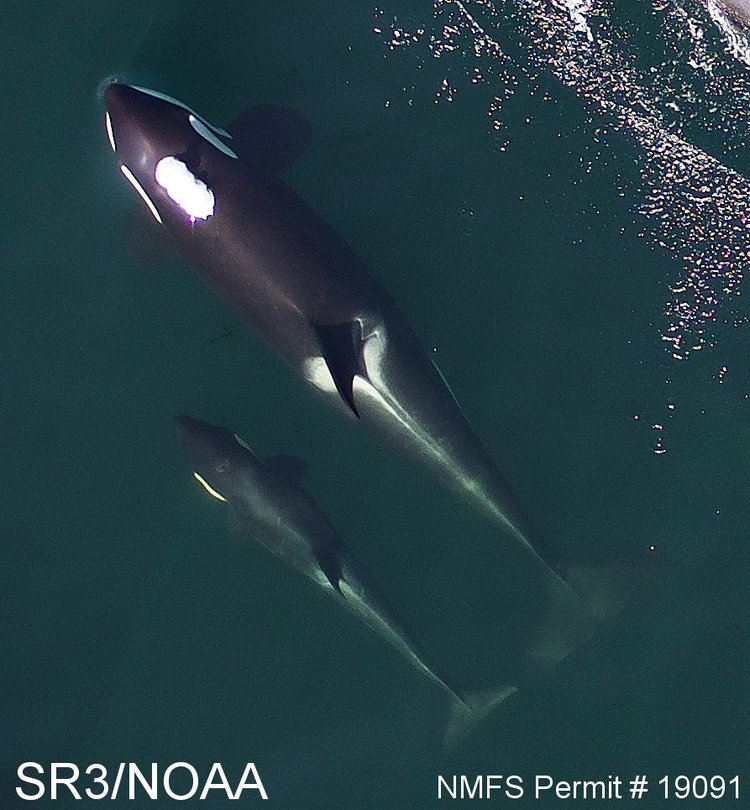

Aerial images of Southern Resident killer whale juvenile J50, taken on May 31, 2017 (left), Aug. 1, 2018 (centre) and Sept. 3, 2018 (right) for comparison. In the 2018 photos, she is in poor body condition revealing a very thin profile, and loss of fat behind the head creating a “peanut head” appearance that has become more prominent over the last month. Images by Holly Fearnbach (SR3) and John Durban (NOAA) obtained with an unmanned drone, piloted non-invasively >100ft above the whales under NMFS research permit #19091.
New aerial images from SR3 (SeaLife Response, Rehabilitation, and Research) in the Pacific Northwest and the U.S. National Oceanic and Atmospheric Administration Fisheries’ Science Center show how much J50’s condition has deteriorated between 2017 and 2018.
Working under a research permit from the U.S. National Oceanic and Atmospheric Administration Fisheries (NOAA), the research team has flown a drone more than 100 feet (31 metres) above the whales to measure the width (fatness) and length (growth) of the whales.
While taking these images, the researches have been able to see the decline in health of J50. The emaciated and ailing three-year-old animal, who is also known as Scarlet, is one of 75 critically endangered southern resident killer whales.
In the 2018 photos, J50 is seen in poor condition with a very thin profile and loss of fat creating a “peanut head” appearance that has become more prominent this month. The latest image was taken on Sept. 3, 2018.
“Our quantitative measurements from these images indicate that her mother (J16) has also declined in condition over the last month, perhaps due to the burden of helping to catch and share food with J50,” SR3 said in a release.

Aerial image of Southern Resident killer whale juvenile J50, swimming alongside her mother (J16) on September 3rd 2018 (right) for comparison. This highlights the small size and thin body profile of J50. Images by Holly Fearnbach (SR3) and John Durban (NOAA) obtained with an unmanned drone, piloted non-invasively >100ft above the whales under NMFS research permit #19091.
In an update on Saturday, NOAA confirmed the J50 was seen swimming almost a kilometre behind the rest of her family, known as J-Pod.
The organization says that her condition did not appear to be improving, nor did they succeed in dosing the whale with the dewormer. Last week, NOAA confirmed parasitic worms had been found in several fecal samples of the J-Pod whales with whom J50 shares fish, including with her mother.
For the rest of the month, the research team will be around the San Juan Islands to document the condition of all of the southern resident killer whales, which will add to a 10-year time series to assess changes in the nutritional health of the population. The data can also be used to support management actions aimed at maintaining an adequate food supply.
With files from The Canadian Press




